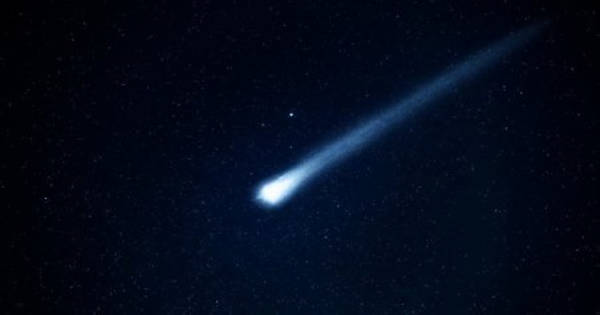A massive comet from our solar system’s outskirts has been discovered in six years of Dark Energy Survey data. Comet Bernardinelli-Bernstein is thought to be 1000 times more massive than a typical comet, making it the largest comet discovered in modern times. It travels inward from the distant Oort Cloud over millions of years in an extremely long orbit. It is the most distant comet discovered on its incoming path, giving us years to observe its evolution as it approaches the Sun, though it is not expected to be visible to the naked eye.
Two astronomers discovered a massive comet after conducting a thorough search of Dark Energy Survey data (DES). The comet, which is estimated to be 100–200 kilometers across, or about ten times the diameter of most comets, is an icy relic thrown out of the solar system by migrating giant planets in the solar system’s early history. This comet is unlike any other seen before, and its enormous size is estimated based on how much sunlight it reflects.
The comet, named Comet Bernardinelli-Bernstein (with the designation C/2014 UN271), was discovered by Pedro Bernardinelli and Gary Bernstein of the University of Pennsylvania among data collected by the 570-megapixel Dark Energy Camera (DECam) mounted on the Victor M. Blanco 4-meter Telescope at Cerro Tololo Inter-American Observatory (CTIO) in Chile. The Department of Energy (DOE) and the National Science Foundation (NSF) are funding the Dark Energy Survey data analysis, and the DECam science archive is curated by the Community Science and Data Center (CSDC) at NSF’s NOIRLab. CTIO and CSDC are NOIRLab programs.
A giant comet has been discovered by two astronomers following a comprehensive search of data from the Dark Energy Survey (DES). It has an extremely elongated orbit, journeying inward from the distant Oort Cloud over millions of years.
DECam, one of the world’s highest-performance wide-field CCD imagers, was designed specifically for the DES and operated by the DOE and NSF between 2013 and 2019. The DOE-funded DECam, which was built and tested at Fermilab. DECam is currently used for programs covering a wide range of science.
DES was tasked with mapping 300 million galaxies across a 5000-square-degree area of the night sky, but it also observed many comets and trans-Neptunian objects passing through the surveyed field over the course of six years. A trans-Neptunian object, or TNO, is an icy body in our solar system that orbits beyond Neptune’s orbit.
Bernardinelli and Bernstein used 15–20 million CPU hours at the National Center for Supercomputing Applications and Fermilab, as well as sophisticated identification and tracking algorithms, to identify over 800 individual TNOs from among the more than 16 billion individual sources detected in the DES’s 80,000 exposures. Thirty-two of those detections were for a single object, C/2014 UN271.
Comets are icy bodies that evaporate as they get closer to the Sun, expanding their comas and tails. The DES images of the object from 2014 to 2018 did not show a typical comet tail, but within a day of the Minor Planet Center announcing its discovery, astronomers using the Las Cumbres Observatory network took new images of Comet Bernardinelli-Bernstein, revealing that it has grown a coma in the last three years, officially classifying it as a comet.

Its current inward journey began at a distance of more than 40,000 astronomical units (au) from the Sun—that is, 40,000 times farther away from the Sun than Earth is, or 6 trillion kilometers (3.7 trillion miles or 0.6 light-years—1/7 of the distance to the nearest star). In comparison, Pluto is approximately 39 au from the Sun on average. This means that Comet Bernardinelli-Bernstein formed in the Oort Cloud of objects, which was ejected during the solar system’s early history. It could be the largest member of the Oort Cloud ever discovered, and it is the first comet on an incoming path to be discovered from such a great distance away.
Bernardinelli-Bernstein is now much closer to the Sun. It was discovered by DES in 2014 at a distance of 29 au (4 billion kilometers or 2.5 billion miles, roughly the distance of Neptune), and as of June 2021, it was at a distance of 20 au (3 billion kilometers or 1.8 billion miles, roughly the distance of Uranus) from the Sun, shining at magnitude 20. The comet’s orbit is perpendicular to the plane of the solar system, and it will approach its closest point to the Sun (known as perihelion) in 2031 when it will be about 11 au away (a little more than Saturn’s distance from the Sun)—but no closer.
Despite its size, it is currently predicted that even at its brightest, skywatchers will need a large amateur telescope to see it. “We have the privilege of discovering possibly the largest comet ever seen—or at least larger than any well-studied one—and catching it early enough for people to watch it evolve as it approaches and warms up,” Gary Bernstein said. “It hasn’t been to the solar system in over 3 million years.”
The astronomical community will closely monitor Comet Bernardinelli-Bernstein, including using NOIRLab facilities, to learn more about the composition and origin of this massive relic from the birth of our own planet. Astronomers believe there are many more undiscovered comets of this size in the Oort Cloud, far beyond Pluto and the Kuiper Belt. The migration of Jupiter, Saturn, Uranus, and Neptune early in their history is thought to have scattered these giant comets to the far reaches of the solar system.
“This is a much-needed anchor on the unknown population of large objects in the Oort Cloud and their connection with early migration of ice/gas giants shortly after the solar system formed,” NOIRLab astronomer Tod Lauer said.
“These observations show the value of long-duration survey observations on national facilities like the Blanco telescope,” says Chris Davis, NOIRLab’s National Science Foundation Program Director. “Finding massive objects like Comet Bernardinelli-Bernstein is critical to our understanding of our solar system’s early history.”
It’s unclear how active and bright it’ll be when it reaches perihelion. Bernardinelli, on the other hand, claims that the Vera C. Rubin Observatory, a future NOIRLab Program, “will continuously measure Comet Bernardinelli-Bernstein all the way to its perihelion in 2031, and probably find many, many others like it,” allowing astronomers to characterize Oort Cloud objects in much greater detail. This study was submitted to the Minor Planet Center.
















